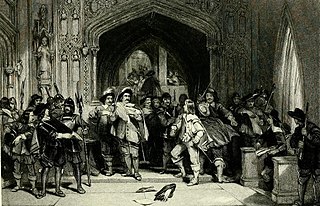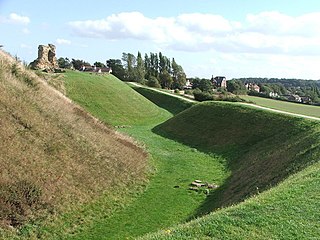Related Research Articles

The Restoration of the Stuart monarchy in the kingdoms of England, Scotland and Ireland took place in 1660 when King Charles II returned from exile in continental Europe. The preceding period of the Protectorate and the civil wars came to be known as the Interregnum (1649–1660).

Colonel Thomas Pride was a Parliamentarian commander during the Wars of the Three Kingdoms, best known as one of the regicides of Charles I and as the instigator of Pride's Purge.

Thomas Grey, Lord Grey of Groby, was an elected Member of Parliament for Leicester during the English Long Parliament, an active member of the Parliamentary party and a regicide. He was the eldest son of Henry Grey, 1st Earl of Stamford, using his father's as his own courtesy title, and Anne Cecil, daughter of William Cecil, 2nd Earl of Exeter.

Sir Hardress Waller, was an English Protestant who settled in Ireland and fought for Parliament in the Wars of the Three Kingdoms. A leading member of the radical element within the New Model Army, he signed the death warrant for the Execution of Charles I in 1649; after the Stuart Restoration in 1660, he was condemned to death as a regicide, a sentence commuted to life imprisonment.

Colonel Adrian Scrope, also spelt Scroope, 12 January 1601 to 17 October 1660, was a Parliamentarian soldier during the Wars of the Three Kingdoms, and one of those who signed the death warrant for Charles I in January 1649. Despite being promised immunity after the Restoration in 1660, he was condemned as a regicide and executed in October.

Major-General Robert Overtonc. 1609 to 1678, was a member of the landed gentry from Yorkshire, who fought for Parliament during the Wars of the Three Kingdoms, and reached the rank of Major General in 1652. A committed republican and religious Independent who sympathised with the Fifth Monarchists, like others with similar views he opposed the establishment of The Protectorate, and was held in the Tower of London from 1655 to 1659.

Mont Orgueil is a castle in Jersey that overlooks the harbour of Gorey; a port on the east coast of the Island. It is known as Gorey Castle by English-speakers, and lé Vièr Châté by Jèrriais-speakers. The castle was first referred to as 'Mont Orgeuil' in an ordinance survey made in 1462, when the castle was under French occupation in the late Middle Ages. The castle was the seat of royal authority on Jersey throughout the medieval period and served as the main fortress on the Island until the construction of Elizabeth Castle in 1594. It is classified as a Grade I listed building.
Henry Smith (1620–1668) was an English Member of Parliament and one of the regicides of King Charles I.
James Temple (1606–1680) was a puritan and English Civil War soldier who was convicted of the regicide of Charles I. Born in Rochester, Kent, to a well-connected gentry family, he was the second of two sons of Sir Alexander Temple, although his elder brother died in 1627. As a child, Temple moved with his father from Rochester to Chadwell St Mary in Essex and then to Etchingham in Sussex, where he settled.

Withcote is a small parish currently comprising a number of scattered dwellings in Harborough, a local government district of Leicestershire. The population is included in the civil parish of Braunston-in-Rutland.

Colonel Francis Hacker was an English soldier who fought for Parliament during the English Civil War and one of the Regicides of King Charles I of England.
Valentine Walton was an English politician, a member of the Parliamentarian faction in the English Civil War, and one of the regicides of King Charles I of England.
Robert Wallop was an English politician who sat in the House of Commons at various times from 1621 to 1660. He supported the Parliamentary cause in the English Civil War and was one of the regicides of King Charles I of England.
Vincent Potter (c.1614–1661) was an army officer in Parliament's army during the English Civil War and was one of the Regicides of King Charles I of England.
Matthew Thomlinson (1617–1681) was an English soldier who fought for Parliament in the English Civil War. He was a regicide of Charles I. Tomlinson was a colonel of horse (cavalry) in the New Model Army and was one of the officers presenting the remonstrance to parliament in 1647. He took charge of Charles I in 1648, until Charles's execution, but refused to be his judge. He followed Oliver Cromwell to Scotland in 1650.
Robert Tichborne was an English soldier who fought in the English Civil War. He was a regicide of Charles I.

Sir Thomas Berkeley of Wymondham, Leicestershire was an English lawyer, soldier and politician. He represented Leicestershire in Parliament and served as Sheriff for Rutland, Warwickshire and Leicestershire.
Between 1642 and 1651 the Channel Islands were involved in an eleven-year-long, wide-scale armed conflict known as the English Civil War, between the Parliamentarians and Royalists over, principally, the manner of England's government and the amount of power the monarch should be able to wield.

The Corn Riots, also known as the Jersey Revolution, was a revolt which took place in Jersey on 28 September 1769. In an example of direct action against government oppression, under the government of Lieutenant Bailiff Charles Lemprière, hundreds of Jerseymen marched from the north of the island to the south and occupied the Royal Court. The revolt is a significant point in Jersey political history, as the powers of legislation were removed from the Royal Court and placed in the States Assembly.
References
- George Reginald Balleine,et al.. Balleine's History of Jersey , Phillimore, 1981, ISBN 0-85033-413-6, ISBN 978-0-85033-413-5
- Raoul Lemprière. History of the Channel Islands, R. Hale, 1974
- Mark Noble. The lives of the English regicides: and other commissioners of the pretended High court of justice, appointed to sit in judgement upon their sovereign, King Charles the First Volume II, J. Stockdale, 1798
Baptism Records Wymondham, Leicestershire, Wills of Thomas Waite, John Waite, and Henry Waite of Wymondham, Leicestershire. Will of Theodore Gulston MD of London.
- Attribution
 This article incorporates text from this source, which is in the public domain : "The lives of the English regicides: and other commissioners of the pretended High court of justice, appointed to sit in judgement upon their sovereign, King Charles the First" Volume II, by Mark Noble (1798)
This article incorporates text from this source, which is in the public domain : "The lives of the English regicides: and other commissioners of the pretended High court of justice, appointed to sit in judgement upon their sovereign, King Charles the First" Volume II, by Mark Noble (1798)